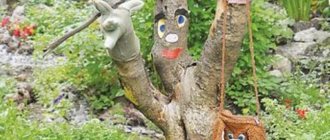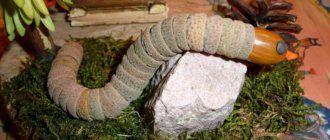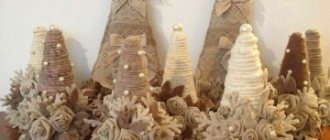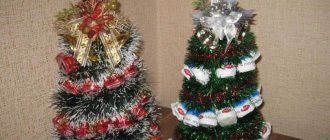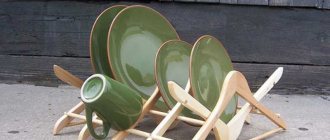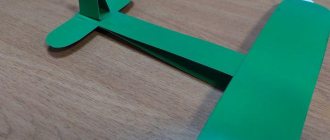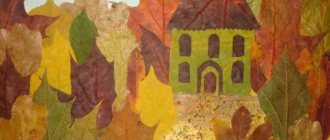Volumetric, interesting and varied applications for children made from paper and other materials. A collection of simple ideas for creative activities.
The development of fine motor skills is of great importance for children. Applique is a great way to develop and train your fingers. Classes give an idea of the structure of the material, color, develop spatial thinking, coordination, precision of movements, and imagination.
This collection includes different themes dedicated to holidays and seasons. All works are presented in a brief summary with links to master classes that are on the website.
What is an application and its benefits for schoolchildren
There are applique lessons on all sorts of topics. You can create works from various types of materials - paper, fabric, natural components. In your work you can use: sunflower seeds, pumpkin seeds, buckwheat, semolina, dried leaves or branches.
Creative compositions are possible on all sorts of topics - vegetables, fruits, animals, people, etc. Teachers can prepare interesting topics for applications that are of interest to schoolchildren. This creative activity is aimed at the broad capabilities of adolescents; it is able to develop the horizons of school-age children, find their talents and determine their abilities.
Applique classes in primary school are a fascinating type of learning for schoolchildren. During these lessons, schoolchildren learn about the world around them, develop their ability to use scissors and pencils, and improve them. The process of thinking about where it is better to stick this or that figure allows children to develop artistic taste and imaginative thinking.
The school lesson on application is multifaceted in the process of developing teenage thinking. Here children learn to recognize geometric shapes, distinguish colors, and natural phenomena. Classes instill accuracy and attentiveness in the student. The need to create this or that image forces the student to determine the characteristics of the object: what color it is, shape and size. To create their own small masterpieces, children need a flight of imagination and inspiration.
Insects
When making insects with children, you need to make sure that the template elements have a large and round shape. Then you will get cute bug-eyed insects. With their impressive size, they look simply magnificent.
The simplest applique for three-year-old children is the image of a caterpillar or ant. This can be done by gluing a series of paper circles with a slight overlap, and then just finish drawing the paws and whiskers.
A snail will also be easy to make. The template for it consists of three elements: the body, the shell and the eyes. It is advisable to draw the spiral shell in advance and leave further design to the kids. You can cut out a spiral house from cardboard.
A butterfly applique would be a great idea—the templates can be printed on a photocopier. This product includes elements of a jigsaw puzzle. The child is given only the outline of a butterfly printed out. Then sectors are cut out from some magazines, the configurations of which together form wings. The child needs to find the right place for each particle.
Applications for 1st grade
For schoolchildren who have just arrived at school, it is important to organize interesting lessons. For children at this age, working with colored paper, pencils, and scissors is exciting. They can work for a long time to create paintings of their own production.
In the first grade, it is important to capture the attention of craftsmen and teach them to think, develop and expand their horizons. It is necessary to add educational materials under humorous and playful moments during appliqué work. So, for example, when studying the topic of animals in the first grade, you can organize a lesson on the topic of creating an image of a particular animal using cut out figures.
In the class, you can give students various tasks on different animals; then, when the work is finished, you can describe the presented animal, thereby preparing a short story about it, i.e. make a presentation of your work.
At the age of seven, children love to play, they love fairy tales and their characters, so applications related to these children’s desires will be well received by them.
Cheerful caterpillar
For a three-dimensional caterpillar craft, you can use an unlimited number of paper ribbons, it all depends on the desired length. Typically, green paper is used, but you can make the caterpillar multi-colored. A large number of colors will help to study them.
Several strips of the same size are cut and a chain is assembled from them. Several ribbons are glued into a circle, and fastened with ribbons also wrapped in a circle. Using felt-tip pens, a smile, eyes and nose are drawn. You can complement the product with separately cut antennae.
Applications for 2nd grade
As the baby grows, his needs in terms of understanding the world around him grow. Teachers need to make appliqué classes more complex; they should be more creative and beautiful. Practical skills and developing experience are important for 2nd grade students. In the 2nd grade, children are already accustomed to school, they begin to understand that it is important to develop their abilities independently, try to read and memorize more, and write down important points in notes.
Applications for 3rd grade
Children grow up, and with this their ability for self-realization grows. Skills in working with scissors, glue, and colored paper have already been developed by the 3rd grade, so at this age it is already possible to structure lessons aimed at developing imagination and flight of thoughts.
In the 3rd grade, you can include in your classes an introduction to different types of techniques for cutting out objects. For example, you can use the technique of folding paper in half or into an accordion and cutting out symmetrical shapes. The interesting technique is not for cutting, but for tearing off figures; the modern technique - decoupage - is fascinating.
Pigtail
It can be woven in several ways. Each of them involves the use of two narrow strips of different colors (for clarity, red and yellow).
One of them, for example, yellow, is folded in half at an angle of 30° so that the right end is wrapped behind the main one (red). Then the right end of the base is placed behind the nearest part of the yellow strip and bent so that the folded section fits tightly to the left end of the second strip.
The left red segment folds over the adjacent yellow one and extends under the other red one. These manipulations continue until the desired length of the braid is achieved. If the original length of the strips is not enough for this, they can be extended.
There are other weaving patterns. To get to know them, just carefully look at the photos of crafts made from strips of paper with step-by-step instructions.
Applications for 4th grade
4th grade schoolchildren are already endowed with the ability to easily work with scissors, draw and glue. Applique classes should have the goal of a more creative approach to work, of creating unique creative works. Children at this age can start working with templates and cut out identical shapes in a faster way.
In addition to school appliqué lessons, children can invent and experiment at home with their parents. Parents, no worse than teachers, can show their children examples of their work and suggest their methods of creative ideas.
Application is exactly the type of useful activity that can unite adults and children in their work. At any age of their student, it is important for parents not to stop the child’s development, but to give him more and more difficult tasks.
Children need the care and affection of their mothers and fathers; creativity is a great way to spend quality time with your child. If applications become a regular activity for you and your child, then you can use non-standard approaches in children's masterpieces. For example, an image of a Christmas tree can be created by gluing 3 green triangles on top of each other.
Snowman - white proportional circles are located one above the other. Children love such associations.
The main thing is that children’s thinking needs to be properly directed, then in the future it will be easier for them to navigate the modern world. Three-dimensional thinking, developed since childhood, helps architects, designers, constructors, artists, etc. Applique lessons force children to adapt and get used to modern living conditions - if you litter in class, be sure to clean up your workplace after yourself, this is how the habit of cleaning everything up after your work is formed.
In appliqué crafts, children express themselves and create their own aesthetic taste. Anyone can do appliqué, and they don’t have to be artists and designers.
Sun
To create a sun you will need:
- Wooden stick;
- Medium size yellow circle -2;
- Glue;
- Ready-made eyes;
- Marker;
- 6 lines yellow;
- 6 lines red.
- We bend the lines in half and glue the two ends. The result is a voluminous drop-shaped shape;
- We take a yellow circle and glue our petal rays to it on the inside. We glue alternating yellow and red rays;
- We close the rays on the other side with a yellow circle, while not forgetting to place a wooden stick inside;
- We form the face of the sun. It should be cheerful and smiling. To do this, glue the eyes and draw a mouth.
